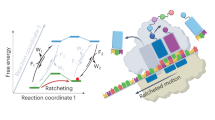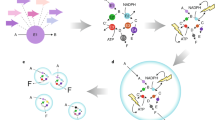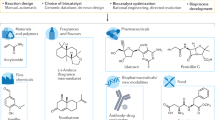Abstract
Biomimetic synthesis describes the field of organic chemistry that aims to emulate the natural, biosynthetic processes toward natural products. As well as providing insight into how molecules are formed in nature, the benefits of this approach to total synthesis are numerous and extend beyond the gains typical of traditional synthesis. For example, using biosynthetic proposals to design a synthetic route can highlight alternative methods to the desired target. The pursuit of biomimetic syntheses also promotes the development of new reactions to prove or disprove a biosynthetic proposal or to unravel mechanistic implications of a proposed biosynthesis and can lead to the identification of new natural products. Here we look at some recent compelling examples and examine how biomimetic synthesis has led to the discovery of new procedures and principles that would not have been found by other approaches.
This is a preview of subscription content, access via your institution
Access options
Subscribe to this journal
Receive 12 print issues and online access
$259.00 per year
only $21.58 per issue
Buy this article
- Purchase on Springer Link
- Instant access to full article PDF
Prices may be subject to local taxes which are calculated during checkout








Similar content being viewed by others
References
Bentley, R. & Bennett, J.W. Constructing polyketides: from Collie to combinatorial biosynthesis. Annu. Rev. Microbiol. 53, 411–446 (1999).
Robinson, R. LXIII.–A synthesis of tropinone. J. Chem. Soc. Trans. 111, 762–768 (1917).
Breslow, R. Biomimetic chemistry. Chem. Soc. Rev. 1, 553–580 (1972).
Barton, D.H.R. Reason and Imagination: Reflections on Research in Organic Chemistry: Selected Papers of Derek H.R. Barton. (World Scientific, 1996).
Taylor, S.K. Biosynthetic, biomimetic and related epoxide cyclizations. A review. Org. Prep. Proced. Int. 24, 245–284 (1992).
Yoder, R.A. & Johnston, J.N. A case study in biomimetic total synthesis: polyolefin carbocyclizations to terpenes and steroids. Chem. Rev. 105, 4730–4756 (2005). An elegant review that puts terpene and steroid biosynthetic research, spanning more than 70 years, into context.
Scholz, U. & Winterfeldt, E. Biomimetic synthesis of alkaloids. Nat. Prod. Rep. 17, 349–366 (2000).
Bulger, P.G., Bagal, S.K. & Marquez, R. Recent advances in biomimetic natural product synthesis. Nat. Prod. Rep. 25, 254–297 (2008).
Brunoldi, E., Luparia, M., Porta, A., Zanoni, G. & Vidari, G. Biomimetic cyclizations of functionalized isoprenoid polyenes: a cornucopia of synthetic opportunities. Curr. Org. Chem. 10, 2259–2282 (2006).
Beaudry, C.M., Malerich, J.P. & Trauner, D. Biosynthetic and biomimetic electrocyclizations. Chem. Rev. 105, 4757–4778 (2005).
de la Torre, M.C. & Sierra, M.A. Comments on recent achievements in biomimetic organic synthesis. Angew. Chem. Int. Ed. Engl. 43, 160–181 (2004).
Nicolaou, K.C., Zipkin, R.E. & Petasis, N.A. The endiandric acid cascade. Electrocyclizations in organic synthesis. 3. “Biomimetic” approach to endiandric acids A-G. Synthesis of precursors. J. Am. Chem. Soc. 104, 5558–5560 (1982).
Nicolaou, K.C., Petasis, N.A. & Zipkin, R.E. The endiandric acid cascade. Electrocyclizations in organic synthesis. 4. “Biomimetic” approach to endiandric acids A-G. Total synthesis and thermal studies. J. Am. Chem. Soc. 104, 5560–5562 (1982).
Heathcock, C.H. The enchanting alkaloids of Yuzuriha. Angew. Chem. Int. Ed. Engl. 31, 665–681 (1992).
Cherney, E.C. & Baran, P.S. Terpenoid-alkaloids: their biosynthetic twist of fate and total synthesis. Isr. J. Chem. 51, 391–405 (2011).
Baldwin, J.E. & Abraham, E. The biosynthesis of penicillins and cephalosporins. Nat. Prod. Rep. 5, 129–145 (1988).
Lane, A.L. & Moore, B.S. A sea of biosynthesis: marine natural products meet the molecular age. Nat. Prod. Rep. 28, 411–428 (2011).
Stork, G. William Summer Johnson, 1913–1995. in Biographical Memoirs vols. 23–24, 182–197 (National Academy Press, 2001).
Davis, E.M. & Croteau, R. Cyclization enzymes in the biosynthesis of monoterpenes, sesterpenes and diterpenes. Top. Curr. Chem. 209, 53–95 (2000).
Maimone, T.J. & Baran, P.S. Modern synthetic efforts toward biologically active terpenes. Nat. Chem. Biol. 3, 396–407 (2007).
Chen, K. & Baran, P.S. Total synthesis of eudesmane terpenes by site-selective C-H oxidations. Nature 459, 824–828 (2009). A report demonstrating a two-phase approach to terpenoid synthesis, modeled on their natural biosynthesis.
Chen, K., Isihara, Y., Galán, M.M. & Baran, P.S. Total synthesis of eudesmane terpenes: cyclase phase. Tetrahedron 66, 4738–4744 (2010).
Ortiz de Montellano, P.R. Hydrocarbon hydroxylation by cytochrome P450 enzymes. Chem. Rev. 110, 932–948 (2010).
Engelin, C.J. & Fristrup, P. Palladium catalyzed allylic C-H alkylation: a mechanistic perspective. Molecules 16, 951–969 (2011).
Giri, R., Shi, B.-F., Engle, K.M., Maugel, N. & Yu, J.-Q. Transition metal-catalyzed C-H activation reactions: diastereoselectivity and enantioselectivity. Chem. Soc. Rev. 38, 3242–3272 (2009).
Davies, H.M.L. & Manning, J.R. Catalytic C-H functionalization by metal carbenoid and nitrenoid insertion. Nature 451, 417–424 (2008).
Newhouse, T. & Baran, P.S. If C-H bonds could talk: selective C-H bond oxidation. Angew. Chem. Int. Ed. Engl. 50, 3362–3374 (2011).
Chen, M.S. & White, M.C. A predictably selective aliphatic C-H oxidation reaction for complex molecule synthesis. Science 318, 783–787 (2007).
Isihara, Y. & Baran, P.S. Two-phase terpene total synthesis: historical perspective and application to the Taxol® problem. Synlett 1733–1745 (2010).
Lin, Y.-Y. et al. Isolation and structure of brevetoxin B from the “red tide” dinoflagellate Ptychodiscus brevis (Gymnodinium breve). J. Am. Chem. Soc. 103, 6773–6775 (1981).
Paz, B. et al. Yessotoxins, a group of marine polyether toxins: an overview. Mar. Drugs 6, 73–102 (2008).
Yasumoto, T., Bagnis, R. & Vernoux, J.P. Toxicity study on surgeonfishes-II. Properties of the principal water-soluble toxin. Nippon Suisan Gakkaishi 42, 359–365 (1976).
Lewis, R.J. The changing face of ciguatera. Toxicon 39, 97–106 (2001).
Nakanishi, K. The chemistry of brevetoxins: a review. Toxicon 23, 473–479 (1985).
Lee, M.S., Qin, G., Nakanishi, K. & Zagorski, M.G. Biosynthetic studies of brevetoxins, potent neurotoxins produced by the dinoflagellate Gymnodinium breve. J. Am. Chem. Soc. 111, 6234–6241 (1989).
Shimizu, Y. Biosynthesis and biotransformation of marine invertebrate toxins. in Natural Toxins: Animal, Plant, and Microbial (ed. J.B. Harris) 123 (Clarendon Press, 1986).
Nicolaou, K.C. The total synthesis of brevetoxin B: A twelve-year odyssey in organic synthesis. Angew. Chem. Int. Ed. Engl. 35, 588–607 (1996). In this review, Nicolaou recalls his proposal for the biosynthesis of ladder polyethers, which he included in a proposal to the National Institutes of Health in 1982.
Baldwin, J.E. Rules for ring closure. J. Chem. Soc. Chem. Commun. 734–736 (1976).
Vilotijevic, I. & Jamison, T.F. Epoxide-opening cascades in the synthesis of polycyclic polyether natural products. Angew. Chem. Int. Ed. Engl. 48, 5250–5281 (2009).
Morten, C.J. & Jamison, T.F. Water overcomes methyl group directing effects in epoxide-opening cascades. J. Am. Chem. Soc. 131, 6678–6679 (2009).
Vilotijevic, I. & Jamison, T.F. Synthesis of marine polycyclic polyethers via endo-selective epoxide-opening cascades. Mar. Drugs 8, 763–809 (2010).
Nakata, T. Total synthesis of marine polycyclic ethers. Chem. Rev. 105, 4314–4347 (2005).
Alvarez, E., Candenas, M.-L., Pérez, R., Ravelo, J.L. & Martín, J.D. Useful designs in the synthesis of trans-fused polyether toxins. Chem. Rev. 95, 1953–1980 (1995).
Hoberg, J.O. Synthesis of seven-membered oxacycles. Tetrahedron 54, 12631–12670 (1998).
Marmsäter, F.P. & West, F.G. New efficient iterative approaches to polycyclic ethers. Chemistry 8, 4346–4353 (2002).
Sasaki, M. & Fuwa, H. Convergent strategies for the total synthesis of polycyclic ether marine metabolites. Nat. Prod. Rep. 25, 401–426 (2008).
Vilotijevic, I. & Jamison, T.F. Epoxide-opening cascades promoted by water. Science 317, 1189–1192 (2007). The first endo -selective cascade of polyepoxide openings that did not use directing groups to guide the reaction process.
Morten, C.J., Byers, J.A., Van Dyke, A.R., Vilotijevic, I. & Jamison, T.F. The development of endo-selective epoxide-opening cascades in water. Chem. Soc. Rev. 38, 3175–3192 (2009).
Morten, C.J., Byers, J.A. & Jamison, T.F. Evidence that epoxide-opening cascades promoted by water are stepwise and become faster and more selective after the first cyclization. J. Am. Chem. Soc. 133, 1902–1908 (2011).
Byers, J.A. & Jamison, T.F. On the synergism between H2O and a tetrahydropyran template in the regioselective cyclization of an epoxy alcohol. J. Am. Chem. Soc. 131, 6383–6385 (2009).
Heathcock, C.H. Nature knows best: An amazing reaction cascade is uncovered by design and discovery. Proc. Natl. Acad. Sci. USA 93, 14323–14327 (1996).
Grube, A., Immel, S., Baran, P.S. & Köck, M. Massadine chloride: a biosynthetic precursor of massadine and stylissadine. Angew. Chem. Int. Ed. Engl. 46, 6721–6724 (2007).
Köck, M., Grube, A., Seiple, I.B. & Baran, P.S. The pursuit of palau'amine. Angew. Chem. Int. Ed. Engl. 46, 6586–6594 (2007).
Kato, H. et al. Notoamides A-D: prenylated indole alkaloids isolated from a marine-derived fungus, Aspergillus sp. Angew. Chem. Int. Ed. Engl. 46, 2254–2256 (2007).
Grubbs, A.W., Artman, I.G.D., Tsukamoto, S. & Williams, R.M. A concise total synthesis of the notoamides C and D. Angew. Chem. Int. Ed. Engl. 46, 2257–2261 (2007).
Greshock, T.J., Grubbs, A.W., Tsukamoto, S. & Williams, R.M. A concise, biomimetic total synthesis of stephacidin A and notoamide B. Angew. Chem. Int. Ed. Engl. 46, 2262–2265 (2007).
Finefield, J.M. & Williams, R.M. Synthesis of notoamide J: a potentially pivotal intermediate in the biosynthesis of several prenylated indole alkaloids. J. Org. Chem. 75, 2785–2789 (2010).
Tsukamoto, S., Umaoka, H., Yoshikawa, K., Ikeda, T. & Hirota, H. Notoamide O, a structurally unprecendented prenylated indole alkaloid, and notoamides P-R from a marine-derived fungus, Aspergillus sp. J. Nat. Prod. 73, 1438–1440 (2010).
Tsukamoto, S. et al. Notoamides F-K, prenylated indole alkaloids isolated from a marine-derived Apergillus sp. J. Nat. Prod. 71, 2064–2067 (2008).
Ding, Y. et al. Genome-based characterization of two prenylation steps in the assembly of the stephacidin and notoamide anticancer agents in a marine-derived Aspergillus sp. J. Am. Chem. Soc. 132, 12733–12740 (2010).
Artman, G.D. III, Grubbs, A.W. & Williams, R.M. Concise, asymmetric, stereocontrolled total synthesis of stephacidins A, B and notoamide B. J. Am. Chem. Soc. 129, 6336–6342 (2007).
Tsukamoto, S. et al. Isolation of notoamide E, a key precursor in the biosynthesis of prenylated indole alkaloids in a marine-derived fungus, Aspergillus sp. J. Am. Chem. Soc. 131, 3834–3835 (2009).
Greshock, T.J. et al. Isolation, structure elucidation, and biomimetic total synthesis of versicolamide B, and the isolation of antipodal (−)-stephacidin A and (+)-notoamide B from Aspergillus versicolor NRRL 35600. Angew. Chem. Int. Ed. Engl. 47, 3573–3577 (2008).
Tsukamoto, S. et al. Isolation of antipodal (−)-versicolamide B and notoamide L-N from a marine-derived Aspergillus sp. Org. Lett. 11, 1297–1300 (2009).
Williams, R.M. Natural product synthesis: Enabling tools to penetrate Nature's secrets of biogenesis and biomechanism. J. Org. Chem. 76, 4221–4259 (2011). A review that summarizes the biosynthetic investigations of the prenylated alkaloids, highlighting unexpected discoveries and development of synthetic technologies.
Kelly, W.L. Intramolecular cyclizations of polyketide biosynthesis: mining for a “Diels-Alderase”? Org. Biomol. Chem. 6, 4483–4493 (2008).
Pohnert, G. Macrophomate synthase: the first structure of a natural Diels-Alderase. ChemBioChem 4, 713–715 (2003).
Stocking, E.M. & Williams, R.M. Chemistry and biology of biosynthetic Diels-Alder reactions. Angew. Chem. Int. Ed. Engl. 42, 3078–3115 (2003).
Kim, H.J., Ruszczycky, M.W., Choi, S., Liu, Y. & Liu, H. Enzyme-catalysed [4+2] cycloaddition is a key step in the biosynthesis of spinosyn A. Nature 473, 109–112 (2011). The first report of an enzyme that exclusively catalyzes a Diels-Alder reaction.
Campbell, C.D. & Vederas, J.C. Biosynthesis of lovastatin and related metabolites formed by fungal iterative PKS enzymes. Biopolymers 93, 755–763 (2010).
Brastianos, H.C. et al. Exiguamine A, an indole-2,3-dioxygenase (IDO) ihibitor isolated from the marine sponge Neopetrosia exigua. J. Am. Chem. Soc. 128, 16046–16047 (2006).
Löb, S., Königsrainer, A., Rammensee, H.-G., Opelz, G. & Terness, P. Inhibitors of indoleamine-2,3-dioxygenase for cancer therapy: can we see the wood for the trees? Nat. Rev. Cancer 9, 445–452 (2009).
Volgraf, M. et al. Biomimetic synthesis of the IDO inhibitors exiguamine A and B. Nat. Chem. Biol. 4, 535–537 (2008). A report on the biomimetic synthesis of exiguamine A and discovery of exiguamine B, which also examines the possible biosynthetic links between the two congeners.
O'Malley, D.P., Li, K., Maue, M., Zografos, A.L. & Baran, P.S. Total synthesis of dimerica pyrrole-imidazole alkaloids: Sceptrin, ageliferin, nagelamide E, oxysceptrin, nakamuric acid, and the axinellamine carbon skeleton. J. Am. Chem. Soc. 129, 4762–4775 (2007).
Walker, R.P., Faulkner, D.J., Van Engen, D. & Clardy, J. Sceptrin, an antimicrobial agent from the sponge Agelas sceptrum. J. Am. Chem. Soc. 103, 6772–6773 (1981).
Kinnel, R.B., Gehrken, H.-P. & Scheuer, P.J. Palau'amine: a cytotoxic and immunosuppressive hexacyclic bisguanidine antibiotic from the sponge Stylotella agminata. J. Am. Chem. Soc. 115, 3376–3377 (1993).
Kinnel, R.B., Gehrken, H.-P., Swali, R., Skoropowski, G. & Scheuer, P.J. Palau'amine and its congeners: a family of bioactive bisguanidnes from the marine sponge Stylotella aurantium. J. Org. Chem. 63, 3281–3286 (1998).
Kato, T., Shizuri, Y., Izumida, H., Yokoyama, A. & Endo, M. Styloguanidines, new chitinase inhibitors from the marine Stylotella aurantium. Tetrahedr. Lett. 36, 2133–2136 (1995).
Kobayashi, J., Suzuki, M. & Tsuda, M. Konbu'acidin A, a new bromopyrrole alkaloid with cdk4 inhibitory activity from Hymeniacidon sponge. Tetrahedron 53, 15681–15684 (1997).
Kobayashi, H. et al. Carteramine A, an inhibitor of neutrophil chemotaxis, from the marine sponge Stylissa carteri. Tetrahedr. Lett. 48, 2127–2129 (2007).
Buchanan, M.S. et al. Natural products, stylissadines A and B, specific antagonists of the P2X7 receptor, and important inflammatory target. J. Org. Chem. 72, 2309–2317 (2007).
Buchanan, M.S., Carroll, A.R. & Quinn, R.J. Revised structure of palau'amine. Tetrahedr. Lett. 48, 4573–4574 (2007).
Grube, A. & Köck, M. Structural assignment of tetrabromostyloguanidine: does the relative configuration of the palau'amines need revision? Angew. Chem. Int. Ed. Engl. 46, 2320–2324 (2007).
Lanman, B.A., Overman, L.E., Paulini, R. & White, N.S. On the structure of palau'amine: evidence for the revised relative configuration from chemical synthesis. J. Am. Chem. Soc. 129, 12896–12900 (2007).
Seiple, I.B. et al. Total synthesis of Palau'amine. Angew. Chem. Int. Ed. Engl. 49, 1095–1098 (2010). The first reported total synthesis of the pyrrole-imidzaole alkaloid palau'amine, corroborating the previously reported structure revision.
Al Mourabit, A. & Potier, P. Sponge's molecular diversity through the ambivalent reactivity of 2-aminoimidazole: a universal chemical pathway to the oroidin-based pyrrole-imidazole alkaloids and their palau'amine congeners. European J. Org. Chem. 237–243 (2001).
Hoffmann, H. & Lindel, T. Synthesis of the pyrrole-imidazole alkaloids. Synthesis 2003, 1753–1783 (2003).
Jacquot, D.E.N. & Lindel, T. Challenge palau'amine: current standings. Curr. Org. Chem. 9, 1551–1565 (2005).
Weinreb, S.M. Some recent advances in the synthesis of polycyclic imidazole-containing marine natural products. Nat. Prod. Rep. 24, 931–948 (2007).
Ma, Z., Lu, J., Wang, X. & Chen, C. Revisiting the Kinnel-Scheuer hypothesis for the biosynthesis of palau'amine. Chem. Commun. (Camb.) 47, 427–429 (2011).
Kobayashi, J. et al. Ageliferins, potent actomyosin ATPase activators from the Okinawan marine sponge Agelas sp. Tetrahedron 46, 5579–5586 (1990).
Baran, P.S., O'Malley, D.P. & Zografos, A.L. Sceptrin as a potential biosynthetic precursor to complex pyrrole-imidazole alkaloids: the total synthesis of ageliferin. Angew. Chem. Int. Ed. Engl. 43, 2674–2677 (2004).
Northrop, B.H., O'Malley, D.P., Zografos, A.L., Baran, P.S. & Houk, K.N. Mechanism of the vinylcyclobutane rearrangement of sceptrin to ageliferin and nagelamide E. Angew. Chem. Int. Ed. Engl. 45, 4126–4130 (2006).
Snyder, S.A., Zografos, A.L. & Lin, Y. Total synthesis of resveratrol-based natural products: a chemoselective solution. Angew. Chem. Int. Ed. Engl. 46, 8186–8191 (2007). A report discussing the use of tricyclic synthons for the synthesis of several oligomeric resveratrol natural products.
Snyder, S.A., Breazzano, S.P., Ross, A.G., Lin, Y. & Zografos, A.L. Total synthesis of diverse carbogenic complexity within the resvertrol class from a common building block. J. Am. Chem. Soc. 131, 1753–1765 (2009).
Stierle, A.A., Stierle, D.B. & Kelly, K. Berkelic acid, a novel spiroketal with selective anticancer activity from an acid mine waste fungal extremophile. J. Org. Chem. 71, 5357–5360 (2006).
Buchgraber, P. et al. A synthesis-driven strcuture revision of berkelic acid methyl ester. Angew. Chem. Int. Ed. Engl. 47, 8450–8454 (2008).
Wu, X., Zhou, J. & Snider, B.B. Synthesis of (−)-berkelic acid. Angew. Chem. Int. Ed. 48, 1283–1286 (2009).
Bender, C.F., Yoshimoto, F.K., Paradise, C.L. & De Brabander, J.K. A concise synthesis of berkelic acid insprired by combining the natural products spicifernin and pulvilloric acid. J. Am. Chem. Soc. 131, 11350–11352 (2009).
Liu, B. & De Brabander, J.K. Metal-catalyzed regioselective oxy-functionlization of internal alkyne: an entry into ketones, acetals, and spiroketals. Org. Lett. 8, 4907–4910 (2006).
De Brabander, J.K., Liu, B. & Au Qian, M. Au(I)- and Pt(II)-catalyzed cycloetherification of ω-hydroxy propargylic esters. Org. Lett. 10, 2533–2536 (2008).
Dehn, R. et al. Molecular basis of elansolid biosynthesis: evidence for an unprecedented quinone methide initiated intramolecular Diels-Alder cycloaddition/macrolactonization. Angew. Chem. Int. Ed. Engl. 50, 3882–3887 (2011). An example of a quinone methide used as a substrate for a Diels-Alder cycloaddition reaction in natural product synthesis.
Nakajima, H., Fujimoto, H., Matsumoto, R. & Hamasaki, T. Biosynthesis of spiciferone A and spicifernin, bioactive metabolites of the phytopathogenic fungus, Cochliobolus spicifer. J. Org. Chem. 58, 4526–4528 (1993).
Eschenmoser, A. Vitamin B12: Experiments concerning the origin of its molecular structure. Angew. Chem. Int. Ed. Engl. 27, 5–39 (1988). A review that describes how the total synthesis of vitamin B12 spurred investigations into its biosynthesis and the origin of the corrin substructure.
Acknowledgements
We thank J.M. Ready and U.K.Tambar (University of Texas Southwestern) for critical reading of this manuscript. We gratefully acknowledge financial support by the National Institutes of Health (CA 90349) and the Robert A. Welch Foundation (I-1422).
Author information
Authors and Affiliations
Corresponding author
Ethics declarations
Competing interests
The authors declare no competing financial interests.
Rights and permissions
About this article
Cite this article
Razzak, M., De Brabander, J. Lessons and revelations from biomimetic syntheses. Nat Chem Biol 7, 865–875 (2011). https://doi.org/10.1038/nchembio.709
Published:
Issue Date:
DOI: https://doi.org/10.1038/nchembio.709
This article is cited by
-
Total synthesis of terpenes via palladium-catalysed cyclization strategy
Nature Chemistry (2020)
-
An eight-step synthesis of epicolactone reveals its biosynthetic origin
Nature Chemistry (2015)
-
Emulation illuminates biosynthesis
Nature Chemistry (2015)
-
De novo branching cascades for structural and functional diversity in small molecules
Nature Communications (2015)
-
A biomimetic domino reaction for the concise synthesis of capreomycidine and epicapreomycidine
Amino Acids (2012)



